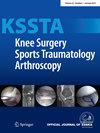Restoring native posterior tibial slope within 4° leads to better clinical outcomes after cruciate-retaining robot-assisted total knee arthroplasty with functional alignment
Abstract
Purpose
The impact of posterior tibial slope (PTS) on clinical outcomes after robot-assisted total knee arthroplasty (RTKA) with functional alignment (FA) remains unclear. This study aimed to evaluate the effect of PTS on clinical outcomes following RTKA with FA.
Methods
A prospectively collected database was retrospectively reviewed for patients who underwent primary cruciate-retaining RTKA (CR-RTKA) with FA using the MAKO robotic system, with a minimum 1-year follow-up. Knees were categorized into two groups: the small change (SC) group (n = 47) with a small PTS change (<4°) and the large change (LC) group (n = 53) with a large PTS change (≥4°). PTS change was defined as differences between pre- and post-operative PTS values. At the 1-year follow-up, clinical outcomes including Knee Society Score (KSS), Western Ontario and McMaster University Index (WOMAC), Forgotten Joint Score-12 (FJS-12) and post-operative complications were compared between groups. A multiple linear regression analysis was conducted to identify independent factors influencing post-operative WOMAC scores.
Results
The SC group demonstrated significantly better post-operative clinical outcomes than the LC group (KSS-functional score: 85.63 ± 13.00 vs. 77.08 ± 18.39, p = 0.026; WOMAC: 10.46 ± 5.36 vs. 16.98 ± 10.69, p < 0.001; FJS-12: 75.94 ± 21.96 vs. 61.37 ± 26.61, p = 0.019). In multivariate regression analysis, PTS change was identified as an independent factor correlated with the post-operative WOMAC score (β: 0.842, p = 0.001). No post-operative complications were observed in either group during the follow-up period.
Conclusions
Restoring the native PTS within 4° leads to better clinical outcomes following CR-RTKA with FA without post-operative complications for up to 1 year. Therefore, efforts to restore the native PTS are critical for achieving optimal short-term clinical outcomes after CR-RTKA with FA.
Level of Evidence
Level III.





 求助内容:
求助内容: 应助结果提醒方式:
应助结果提醒方式:


